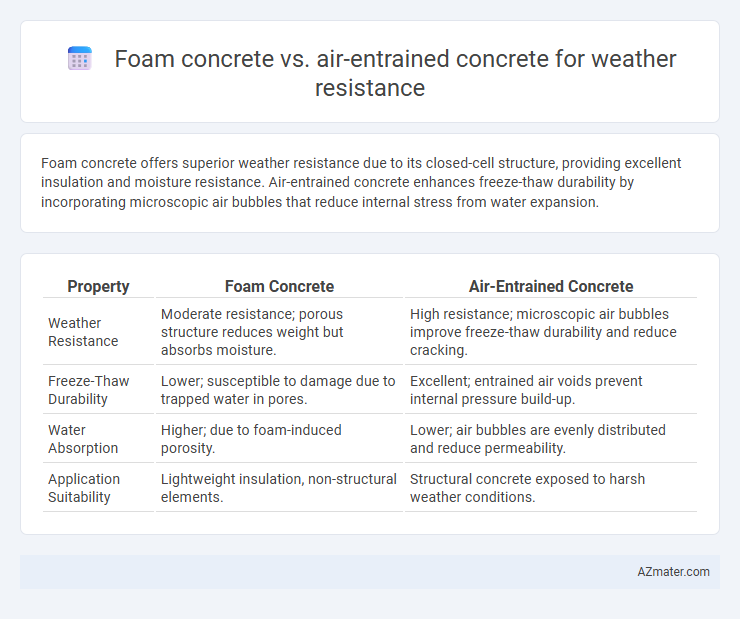Foam concrete offers superior weather resistance due to its closed-cell structure, providing excellent insulation and moisture resistance. Air-entrained concrete enhances freeze-thaw durability by incorporating microscopic air bubbles that reduce internal stress from water expansion.
Table of Comparison
| Property | Foam Concrete | Air-Entrained Concrete |
|---|---|---|
| Weather Resistance | Moderate resistance; porous structure reduces weight but absorbs moisture. | High resistance; microscopic air bubbles improve freeze-thaw durability and reduce cracking. |
| Freeze-Thaw Durability | Lower; susceptible to damage due to trapped water in pores. | Excellent; entrained air voids prevent internal pressure build-up. |
| Water Absorption | Higher; due to foam-induced porosity. | Lower; air bubbles are evenly distributed and reduce permeability. |
| Application Suitability | Lightweight insulation, non-structural elements. | Structural concrete exposed to harsh weather conditions. |
Introduction to Foam Concrete and Air-Entrained Concrete
Foam concrete, a lightweight material produced by mixing cement slurry with foam, offers excellent thermal insulation and durability under harsh weather conditions. Air-entrained concrete incorporates microscopic air bubbles through admixtures, improving freeze-thaw resistance and reducing internal stress caused by moisture expansion. Both materials enhance weather resistance, with foam concrete excelling in insulation and air-entrained concrete providing superior durability against freezing cycles.
Composition and Production Methods
Foam concrete incorporates a stable foam mixture combined with cement and water, creating a highly porous structure that enhances insulation and weather resistance by reducing water permeability. Air-entrained concrete is produced by introducing microscopic air bubbles through air-entraining agents during mixing, which improves freeze-thaw durability and minimizes surface scaling in harsh weather conditions. The production of foam concrete requires precise foam generation and controlled mixing procedures, while air-entrained concrete depends on accurate dosing of air-entraining admixtures to ensure consistent bubble distribution throughout the concrete matrix.
Key Properties Relevant to Weather Resistance
Foam concrete offers superior thermal insulation and lower permeability due to its closed-cell structure, enhancing its resistance to freeze-thaw cycles and moisture penetration. Air-entrained concrete incorporates microscopic air bubbles that improve freeze-thaw durability by providing space for ice expansion, reducing internal stress and cracking. Both materials improve weather resistance, but foam concrete excels in thermal insulation while air-entrained concrete primarily enhances durability against freeze-thaw damage.
Mechanisms of Weather Resistance
Foam concrete exhibits superior weather resistance through its closed-cell structure, which minimizes water absorption and enhances freeze-thaw durability by trapping air within uniform, microscopic bubbles. Air-entrained concrete improves resistance by incorporating intentional microscopic air pockets that relieve internal pressure from freezing water, thus reducing cracking and scaling. Both materials utilize entrapped air to mitigate damage from moisture and temperature fluctuations, but foam concrete's higher porosity and lower density provide enhanced insulation against weather-induced stress.
Comparative Porosity and Moisture Penetration
Foam concrete exhibits higher porosity compared to air-entrained concrete, resulting in increased moisture absorption and reduced weather resistance. Air-entrained concrete contains uniformly distributed microscopic air bubbles that improve freeze-thaw durability by minimizing moisture penetration and internal cracking. Consequently, air-entrained concrete offers superior performance in harsh weather conditions due to its optimized pore structure and enhanced resistance to water ingress.
Performance under Freeze-Thaw Cycles
Foam concrete exhibits superior insulation properties but lower durability under freeze-thaw cycles due to its open-cell structure, leading to increased water absorption and potential damage. Air-entrained concrete incorporates microscopic air bubbles that enhance resistance to freeze-thaw damage by providing space for ice expansion, significantly improving weather resistance and structural longevity. Studies show air-entrained concrete reduces surface scaling and internal cracking, making it more effective in climates with frequent freeze-thaw cycles.
Resistance to Chemical and Environmental Attack
Foam concrete exhibits excellent resistance to chemical and environmental attack due to its closed-cell structure, which limits water ingress and reduces the potential for freeze-thaw damage. Air-entrained concrete enhances durability against weathering by incorporating microscopic air bubbles that improve resistance to freeze-thaw cycles and reduce internal cracking caused by moisture expansion. Both materials offer improved weather resistance compared to conventional concrete, but foam concrete provides superior chemical resistance in aggressive environments such as sulfate-rich soils or marine exposure.
Long-Term Durability in Harsh Climates
Foam concrete exhibits superior long-term durability in harsh climates due to its closed-cell structure, which minimizes water absorption and resists freeze-thaw cycles effectively. In contrast, air-entrained concrete relies on microscopic air bubbles to enhance freeze-thaw resistance but may still be vulnerable to prolonged moisture ingress and chemical attacks. The lower permeability and enhanced thermal insulation of foam concrete contribute significantly to its weather resistance and sustained structural integrity over time.
Practical Applications in Weather-Exposed Structures
Foam concrete offers superior insulation and water resistance due to its closed-cell structure, making it highly suitable for weather-exposed foundations and roofing applications. Air-entrained concrete enhances freeze-thaw durability by incorporating microscopic air bubbles, which reduce internal stress in cold climates, ideal for pavements and bridges. Selecting between foam and air-entrained concrete depends on balancing insulation needs with freeze-thaw resistance in structures exposed to harsh weather conditions.
Summary: Choosing the Right Concrete for Weather Resistance
Foam concrete offers superior insulation and lightweight properties, making it highly effective for weather resistance in cold climates by reducing thermal conductivity and minimizing frost damage. Air-entrained concrete enhances durability in freeze-thaw cycles by incorporating microscopic air bubbles that allow expansion and contraction without cracking, ideal for harsh winter conditions. Selecting the right concrete depends on balancing insulation needs and structural demands, with foam concrete favored for thermal efficiency and air-entrained concrete preferred for robust freeze-thaw resilience.

Infographic: Foam concrete vs Air-entrained concrete for Weather resistance
 azmater.com
azmater.com